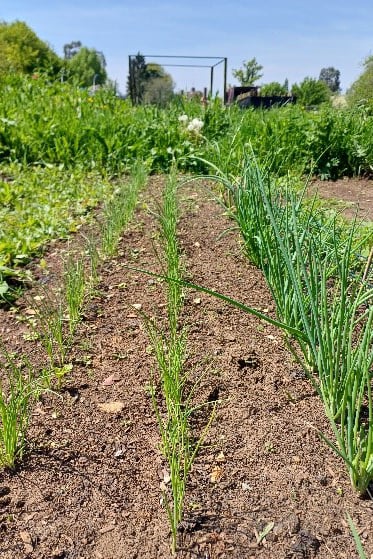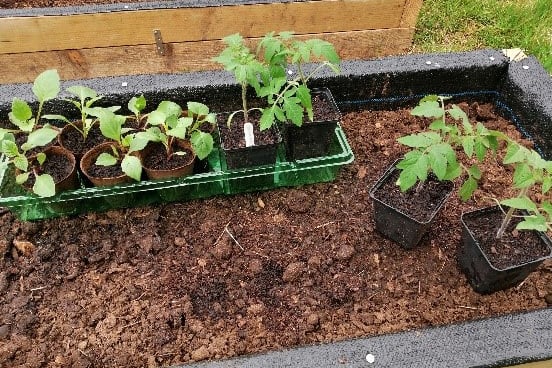RHS Plant Health Advisor Yana Konoplin explores the many benefits of direct sowing seed outdoors, and her tips to maximise your direct-sown harvest

 Every year, Yana Konoplin, Plant Health Advisor at RHS Wisley, grows the whole science team a pumpkin each to carve for Halloween. Here she explains how and when to sow seeds straight into the ground, and the importance of little-and-often successional sowing, while experimenting with intercropping for the first time.
Every year, Yana Konoplin, Plant Health Advisor at RHS Wisley, grows the whole science team a pumpkin each to carve for Halloween. Here she explains how and when to sow seeds straight into the ground, and the importance of little-and-often successional sowing, while experimenting with intercropping for the first time.
Before I got my first allotment plot, I wanted to grow nothing but herbs and flowers – beautiful dahlias and coneflowers, sweet-scented lemon balm and mint, aromatic dill and parsley. But once I had my plot, I could not resist growing veggies and fruit too.
With its warmer weather and longer days, May is a month when I like to sow lots of different crops outdoors. I know sowing seeds indoors has advantages, for example getting tender plants like tomatoes off to an earlier start, but it also has disadvantages – like taking up room I don’t have. There are also other benefits from sowing seeds straight in the soil; for example, I need less potting compost.
 Most importantly though, direct sowing means there isn’t any root disturbance. This can make seedlings sulk for a bit whilst settling in, causing their growth to ‘stall’. This is especially true of fast-growing plants like radishes, and almost essential for anything where the root or base of the stem is the main deal, like carrots and beetroot.
Most importantly though, direct sowing means there isn’t any root disturbance. This can make seedlings sulk for a bit whilst settling in, causing their growth to ‘stall’. This is especially true of fast-growing plants like radishes, and almost essential for anything where the root or base of the stem is the main deal, like carrots and beetroot.
However, it’s important to keep in mind that soil can still be quite cold and wet even in May, and some seeds might not germinate. Late frosts this month can also kill young and tender seedlings.
 To avoid disappointment I do sow a few ‘back-up’ sweetcorn, runner beans and cucumbers under cover. The chance of late frost means I always have cloches and old fleece to hand. I also try not to forget about hungry wildlife, who find the cold nights hard too.
To avoid disappointment I do sow a few ‘back-up’ sweetcorn, runner beans and cucumbers under cover. The chance of late frost means I always have cloches and old fleece to hand. I also try not to forget about hungry wildlife, who find the cold nights hard too.
I learned the hard way that it is also a good idea to practice successional sowing – planting a small batch of seeds every two or three weeks. This way I don’t use all of my seeds at once and have a steady supply of vegetables for a longer period.
I make sure my seeds and seedlings are kept well-watered, and outdoors it is important (though hard) to also keep them free of weeds. This gives them a better chance to get the water and nutrients they need, without sharing with too many other plants.
This season I am trying something new for me – intercropping. This is a great way to grow fast- and slow-growing crops in the same bed at the same time. By the time the faster crop is ready to harvest, the slower one is starting to fill the gaps and ready to enjoy more light.
I will use my new raised beds for fast-growing salad leaves with slow-growing sweetcorn, and do the same with radishes and parsnips. Examples of other quick crops are corn salad, small lettuces, radishes, spinach and spring planted shallots, while slow-growing crops include parsnips, tomatoes, sweetcorn, leeks and winter brassicas. Any pair will do but whichever I choose, they need to have separate harvesting seasons. Hopefully, they will work just fine and I will enjoy harvesting even more from the space I have.
Pick of the crop
 Look for the RHS Award of Garden Merit (AGM) when buying vegetable seed or small plants. You can also download the RHS lists of recommended cultivars.
Look for the RHS Award of Garden Merit (AGM) when buying vegetable seed or small plants. You can also download the RHS lists of recommended cultivars.
About the author – Yana Konoplin
Yana is a member of the Plant Health team at RHS Wisley, where she works as an entomologist and pathologist. She has an allotment, which is gradually evolving into a system of raised beds as she builds them from offcuts.

